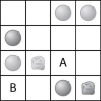Multiple Choice
After reading the paragraphs below, answer the questions that follow.
During a summer study abroad program, you travelled to Austria to study genetics at the University of Vienna. While you were there, a momentous discovery was made: some of Gregor Mendel's original lab books and notes were found to be buried outside of the abbey where he lived. It just so happened that the professor you were working with obtained copies of these notes and enlisted your help to decipher them.
You hired a translator to translate Mendel's notes from Czech to English, and using your knowledge of modern genetics (which Mendel did not have!) you were able to construct a partial Punnett square (shown below) . Because the notebook was damaged from being buried for so long, this is the only information that you have regarding a cross that Mendel must have performed. Your professor has tasked you with figuring out more about this experiment.

-In pea plants, round peas are dominant (R) and shriveled peas are recessive (r) and yellow peas (shown as light gray in Punnett square) are dominant (Y) and green peas (dark gray) are recessive (y) . Using this information and the partial Punnett square above, what were the phenotypes of the parental plants that were used in this cross by Mendel?
A) Rryy and RrYy
B) Rryy and rrYy
C) RRyy and rryy
D) RrYy and RrYy
Correct Answer:

Verified
Correct Answer:
Verified
Q2: Linked genes generally<br>A) do not follow the
Q8: All the offspring of a cross between
Q27: How many sex chromosomes are in a
Q29: A man and his wife are having
Q38: Which of the following is an example
Q64: The expression of both alleles for a
Q66: Varieties of plants in which self-fertilization produces
Q66: Which of the following statements best explains
Q73: You are looking at an unknown cell
Q74: Which of the following is essentially the